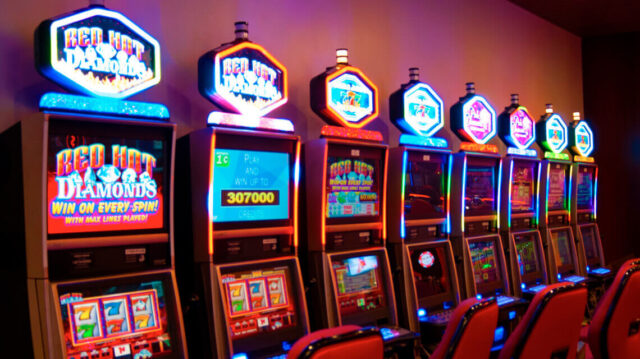
Slot games have come a long way since their humble beginnings as mechanical one-armed bandits. Today, we find ourselves immersed in a world of mobile marvels, where the thrill of spinning the reels can be experienced at our fingertips.
The Origins: Mechanical Machines

The story of slot games begins in the late 19th century when the first mechanical machines emerged. These early machines, often referred to as one-armed bandits due to the lever on the side that players pulled to set the reels in motion, featured simple mechanisms and limited winning combinations. They were primarily found in bars and saloons, offering patrons a chance to try their luck and win a few coins.
However, these mechanical were far from sophisticated. They typically consisted of three spinning reels adorned with various symbols, such as horseshoes, bells, and playing card suits. When the lever was pulled, the reels would start spinning, and if the symbols aligned in a specific pattern, the player would be rewarded with a payout.
The Emergence of Online Games: The Internet Revolution
The widespread adoption of the internet in the late 20th century revolutionized the gambling industry, and slot games were no exception. Online casinos like doghouse megaways try demo began offering virtual games that could be played from the comfort of one’s home. This accessibility attracted a whole new audience to games, and the industry experienced exponential growth.
Online games brought unprecedented convenience to players. No longer bound by physical locations, players could access their favorite games from their computers or mobile devices. The vast selection of online slot games offered an abundance of choices, catering to different preferences and tastes. Additionally, online casinos provided the opportunity to play for real money, further amplifying the excitement and thrill of the games.
The First Electric Machines: Innovations in Technology

As technology advanced, so did slot machines. In the 1960s, the first electric machines were introduced, replacing mechanical components with electrical ones. This innovation allowed for more complex gameplay and the introduction of new features. Electric machines also paved the way for the use of random number generators (RNGs) to determine the outcomes, ensuring fairness and eliminating any possibility of manipulation.
With the introduction of electricity, the machines became more reliable and easier to operate. The spinning reels were now powered by electric motors, eliminating the need for manual pulling of the lever. This transition also allowed for the incorporation of more intricate designs and themes, making the machines visually appealing.
The Introduction of Fruit Symbols
One significant milestone in the history of slot games was the introduction of fruit symbols. In the early 20th century, to circumvent gambling laws, some machines began using fruit symbols instead of traditional playing card symbols. These fruit machines became incredibly popular, and iconic fruit symbols like cherries, lemons, and plums are still associated with classic slots today.
The use of fruit symbols added a new dimension to these games, injecting a sense of fun and simplicity. The brightly colored fruits on the reels captured the attention of players and made the games more visually appealing. This shift also marked the birth of classic slots, which are still beloved by many enthusiasts who appreciate the nostalgic charm and straightforward gameplay.
The Evolution of Electronic Devices

The transition from mechanical to electronic machines marked a turning point in the history of slot games. With the advent of microprocessors and computer technology, machines became more sophisticated and offered a wider range of features. The introduction of video displays also allowed for more visually appealing graphics and animations.
The integration of electronics revolutionized the game industry. The mechanical reels were replaced by video screens, which allowed for more dynamic and engaging gameplay.
The computerized nature of these machines made it possible to incorporate advanced features such as multiple paylines, bonus rounds, and different game modes. This shift sparked a new era of slot games, captivating players with their enhanced interactivity and immersive experiences.
The Rise of Video Games
In the 1990s, video slot games took the industry by storm. These machines featured digital displays instead of physical reels, allowing for a greater variety of themes and gameplay elements.
Video slots opened up a whole new world of possibilities for game designers, as they could incorporate interactive bonus rounds, animated characters, and immersive storylines into their creations.
The advent of video slot games brought a cinematic quality to the slot game experience. The vibrant graphics, captivating animations, and thematic soundtracks transported players into different worlds, immersing them in engaging narratives.
These advancements not only made the games visually appealing but also added a new layer of entertainment, turning slot games into a form of interactive digital entertainment.
Mobile Slots: Gaming on the Go
With the advent of smartphones and tablets, the world of slot games became even more accessible. Mobile slots allowed players to enjoy their favorite games anytime, anywhere.
Developers optimized the games for smaller screens, ensuring a seamless and immersive experience on mobile devices. The convenience of mobile slots further contributed to the popularity of slot games among a wider demographic.
The Impact of Advanced Graphics and Sound Effects on Slot Games

As technology continued to advance, slot games became increasingly visually stunning and sonically captivating. High-definition graphics, intricate animations, and immersive sound effects added a new layer of excitement to the gameplay.
These advancements not only enhanced the player experience but also opened up opportunities for game developers to create more engaging and immersive slot games.
The integration of advanced graphics and sound effects revolutionized the aesthetics of slot games. Stunning visuals, rich colors, and detailed animations brought the game symbols and themes to life.
Sound effects and music were carefully crafted to heighten the excitement and create an immersive atmosphere. Whether it’s the satisfying “ding” of a winning combination or the epic soundtrack during a bonus round, the audio-visual elements of slot games played a crucial role in enhancing overall enjoyment.
Conclusion
In conclusion, the history of slot games is a testament to the power of innovation and technological advancements. From their mechanical origins as one-armed bandits to the mobile marvels of today, slot games have continuously evolved to meet the changing needs and desires of players.
As we look ahead, it’s clear that the future holds even more exciting possibilities for slot games, ensuring that the thrill of spinning the reels will continue to captivate audiences for years to come.









